Borussia-Park: Borussia Mönchengladbach
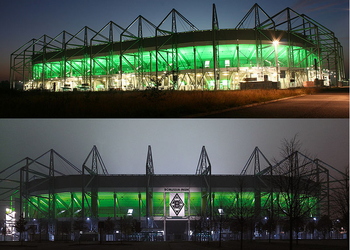
By Blue-Letter at German Wikipedia. (Own work) [Public domain], via Wikimedia Commons & By mr.schnabel (Nordpark Stadion Borussia Mönchengladbach) [CC BY-SA 2.0], via Wikimedia Commons
Borussia-Park is located in the North Rhine-Westphalia district of Germany and is the home stadium of the Bundesliga team Borussia Mönchengladbach. It opened in 2004 and was designed to replace Mönchengladbach’s former home, Bökelberg Stadium. This was a smaller ground and failed to reach the criteria necessary for the safety of supporters in the modern era.
The stadium cost around €85 million to build and contains most of the amenities that you’d expect to find in a modern-day ground. There are VIP lounges, bars for supporters to get a drink in and, as is the case with any stadium worth its salt, a fan shop where supporters can part with their hard-earned cash. The ground can house over 54,000 people but because more than 16,000 of them are in a standing area it is converted into an all-seater stadium for European games.
Stats
| Borussia-Park Stats | |
|---|---|
| Year Opened | 2004 |
| Capacity | 54057 |
| Average Attendance | 51715 |
| Record Attendance | 54010 () |
| Pitch Size | 105 x 68 (7140) |
| Owner | Borussia Mönchengladbach |
| Clubs Hosted | Borussia Mönchengladbach |
| First Fixture | Borussia Mönchengladbach v Borussia Dortmund (14/08/2004) |
| Borussia Mönchengladbach Stats | |
|---|---|
| Year Founded | 1900 |
| Nickname | Die Fohlen, Die Borussen |
| Club Mascot | Jünter |
| Rivals | FC Köln, Borussia Dortmund, Bayern Munich |
| Previous Stadiums | Bökelberg Stadium |
| Kit | White & Green (Home) / Green Patterned (Away) / Black (Third) |
| Training Ground | Borussia-Park Training Ground |
| Shirt Sponsor | flatex |
| Team Owner | Fan Owned |
| Record Goalscorer | Jupp Heynckes (195) |
| Record Appearances | Berti Vogts (419) |
Borussia-Park Photos
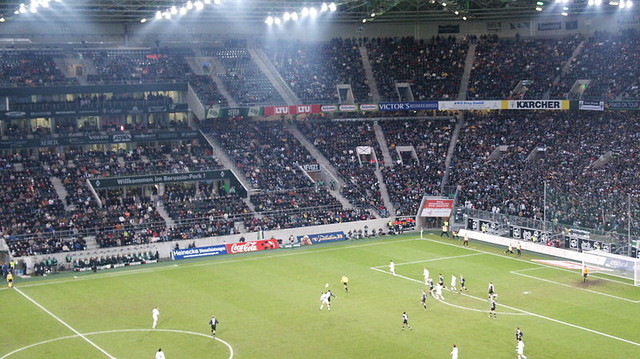
By Massel tow (Own work) [CC BY-SA 2.0 de]
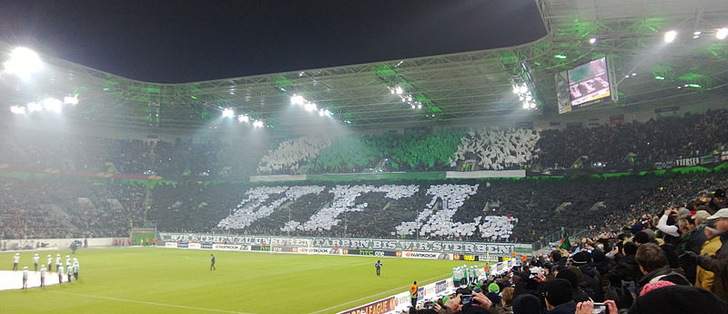
By Clemens Vasters from Viersen
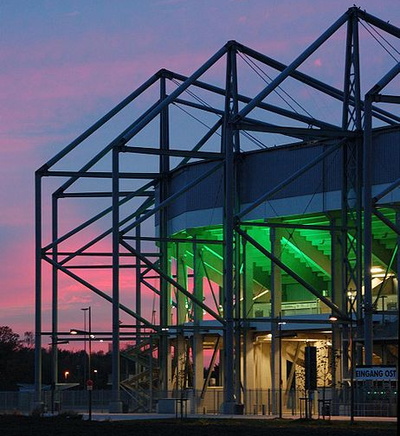
By Marcel Meier [CC BY-SA 2.0]
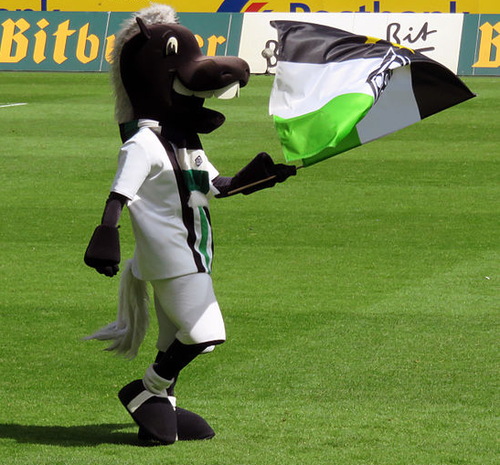
By Heynckesjupp (Own work) [CC BY-SA 4.0]

Nelson / Flickr.com
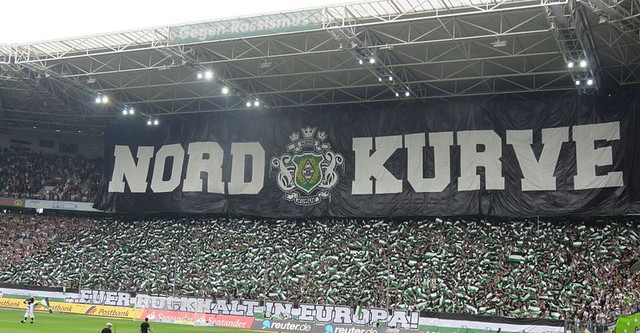
By Heynckesjupp (Own work) [CC BY-SA 4.0]
Borussia-Park Seating Plan and Where to Sit

Though Borussia-Park is built in the typical ‘European Style’ of having a bowl of continuous seating, is it still split into four distinct areas for the purposes of easy identification. These stands are named after their geographical location, with the Osttribüne to the East etc. Here’s some information on each:
- Osttribüne – Named after the area of the city where the ground is located, The Gorgie Stand was completed in 1997 and houses one of the club’s main hospitality ares, The Gorgie Suite.
- Westtribüne – Unsurprisingly, this is the main stand in the stadium. It houses the changing rooms, the dugouts, the Director’s Box and the players’ tunnel.
- Südtribüne – This is where the most vocal Hearts fans tend to sit. It is built at an angle just shy of 34 degrees – the maximum angle permitted for a stand in a football ground.
- Nordkurve – Also known as the School End, this stand houses the away supporters and lost 280 seats from its capacity in 2005 when the pitch was lengthened in order to meet UEFA requirements.
Borussia Mönchengladbach Ticket Prices
Compared to the Premier League, tickets for Bundesliga games are generally very reasonable and that’s no different when it comes to Borussia Mönchengladbach matches. In part that’s because there are so many places within German grounds to watch games from, including standing areas. Here are the cheapest and most expensive ticket prices for each age group:
- Adults: €14.50 – €44.50
- Concessions: €11 – €24
- Kids: €7
How To Get Borussia Mönchengladbach Tickets
The best and easiest way to get tickets for Mönchengladbach games is via the club’s own online portal, though you might be best served by knowing a basic bit of German if you choose to go down that route. If you don’t then you can call the club directly and hope that you get an English speaking operator.
Where to Buy
Getting To Borussia-Park
Mönchengladbach is in the North Rhine-Westphalia area of Germany, so it’s not as easy to get to as the likes of Berlin or Munich but it’s still easier to reach than Siberia, so count your blessings. Here are some of the usual routes you’ll want to consider:
Train – A train from London St. Pancras International to Mönchengladbach would take a little over six hours, with two changes. You’ll head to Brussels first before changing and making your way to Aachen. From there it’s just under an hour to Mönchengladbach. The central station is about two kilometres from the ground and there’s no closer station or tram stop, so it’s a walk, a bus or a taxi.
Bus – The club runs a match day service every twenty minutes or so to the ground from the Central Station. If you’re heading on a non-match day or you’d just prefer to get use public transport then the bus numbers seven or seventeen should do it for you.
Car – On a match day the stadium can only be accessed via the A 61 then the B230.
By Air – Düsseldorf International Airport is the closest to Mönchengladbach and is about 35 kilometres away from the city centre. That’s where you’ll be wanting to fly into.
Taxi – A taxi from the train station to the ground will take about fifteen minutes, depending on traffic and should cost you in the region of €20.
Parking Near Borussia-Park
There are three car parks at Borussia-Park. One is for VIPs, one is for the press and the other is for normos.
Useful Resources
Borussia-Park Hotels
Mönchengladbach is one of Germany’s less visited cities but that doesn’t mean that it doesn’t have plenty to offer. Here are some of our favourite hotels in the area:
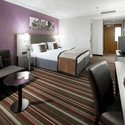
Leonardo Hotel Monchengladbach - £50+
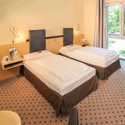
Best Western Plus Crown Hotel - £60+
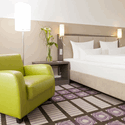
Dorint Parkhotel Mönchengladbach - £75+
Pubs and Bars Near Borussia-Park
Germany is, in general, a great country to go for a drink or two in. Mönchengladbach has that in common with the rest of the cities around the place, so here are some of our favourite places to go for a pre-match pint:
The Pógs - Irish Pub
FohlenSportsBar
Sports Treff Salonika
Facilities
As one of the newer stadiums in the Bundesliga it’s fair to say that Borussia-Park boasts some of the better facilities in Germany. You’ll find lots of places to buy a drink or a bite to eat as well as decent views from most seats. The seats are also very comfortable, with plenty of room.
Hospitality
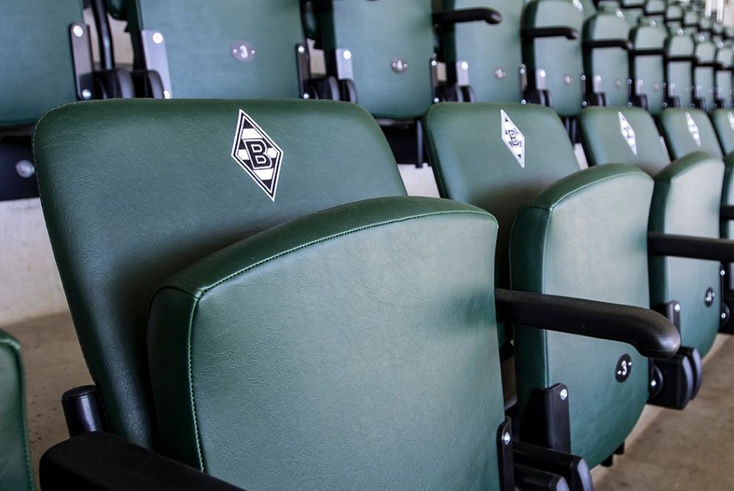
The hospitality area of Borussia-Park is referred to as the ‘Business Area’, so that might give you some indication of what you’re likely to experience there. Here’s a little bit of information about the sort of experience that you can expect:
- Lodges – Private lodges are similar to what we would call boxes in the UK, except they’re basically maxed out versions of these. Let’s be honest, they can take anywhere from 12 to 56 people so that’s pretty impressive by anyone’s standard
- Business Seats – A business seat ticket will give you access to the top quality business section of the ground in The West Stand. You’ll also get to enter the Business Lounge two and a half hours before kick-off and for two hours after the match has finished. You’ll get access to warm and cold buffet food as well as a selection of complimentary drinks. Highlights of the Gladbach match are shown on televisions throughout the lounge, as are any other live football matches. You’ll get the chance to see an interview take place with a Borussia first-team player after the game, too.
Private Hire
The ‘lodges’ are the perfect location for any type of small meeting or conference, with different areas of the stadium also available for your private use should this be something you want to do.
Stadium Tours & Museum
Borussia-Park has some excellent sights that you’d be a fool to miss out on if you’re heading to the area. Tours of the stadium last for about an hour and a half and take in plenty of behind-the-scenes locations such as the changing rooms, the players’ tunnel, the pitch side and the stadium’s own prison area! Tours take place at 3pm and 5pm on Fridays, 11am and 1pm on Saturdays and at 10am, 11am, 12pm and 1pm on Sundays. They are conducted in German and cost €5 or €10 if you want to see the museum too, which costs €7 if you want to visit that separately. There are tours on match days but they are much more expensive at €27!
About Borussia Mönchengladbach
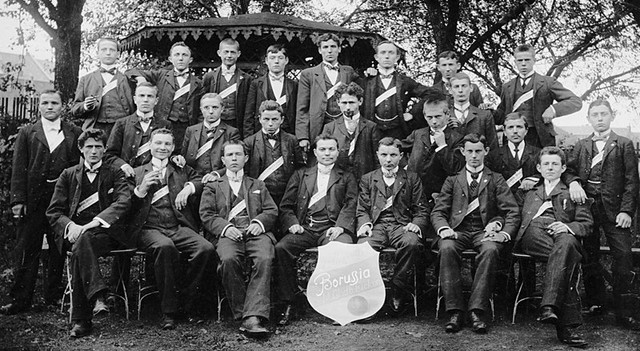
The club’s full title is Borussia VfL 1900 Mönchengladbach e.V., but it is more commonly known as simply Borussia Mönchengladbach or even just Gladbach. Formed in 1900, the club really rose to prominence during the 1970s when they won the Bundesliga five times. It was during that decade that the club earned its nickname of ‘The Foals’, owing to the young age of the squad and combined with their ability to play fast, aggressive football.
Nowadays they are the fifth largest team in Germany, boasting more than 75,000 members. The start of the 1980s saw Mönchengladbach slip away from the top part of the table, with one last hurrah in 1984 seeing them finish level on points with the champions VfB Stuttgart but missing out on the title through goal difference. To date they have won the Bundesliga five times, the DFB-Pokal three times, the German Supercup once and the UEFA Cup twice. They reached the final of the European Cup in 1977 but lost out to Liverpool who won the cup for the first time.
Borussia-Park History
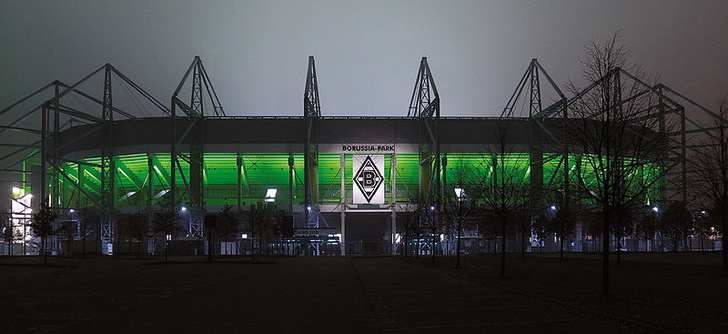
Borussia-Park has the ability to welcome just shy of 55,000 supporters through its doors. This is limited to 54,067 for Bundesliga games and to 46,249 for European matches. The stadium was built to replace the significantly smaller and less impressive Bökelbergstadion, or Bökelberg Stadium, which could only house 34,500 people. The diminutive size of the club’s old ground was limiting their ability to make money through ticket sales and the like, meaning that they struggled financially and fell further and further behind the Bundesliga’s major stadiums such as the Westfalenstadion and the Bayern Arena.
It took four years to build the new stadium at a cost of a little under €87 million. It was opened officially on the 30th of July 2004 but didn’t host its first match until two weeks later when Mönchengladbach welcomed their rivals Borussia Dortmund. The home side lost 3-2. As well as having the ability to house over 59,000 supporters, Borussia-Park also has around 1700 business seats and 684 VIP lodges. The stadium was built with adaptability in mind. The Northern section of the ground is a safe-standing section but is converted to seating for international matches, whilst the Southern Stand can do the same thing should the occasion require it.
Future Developments
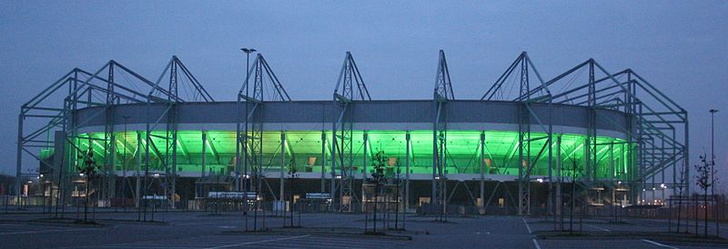
In 2016 Borussia Mönchengladbach used the money from their participation in the Europa League to install something every fan would love to see their club put in place – a huge beer garden. They also built a 131 room hotel at the ground which people can presumably stagger back to from the beer garden.
